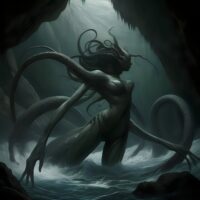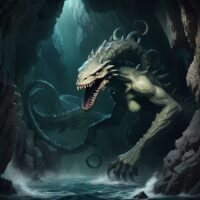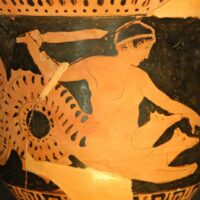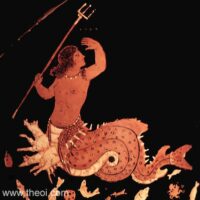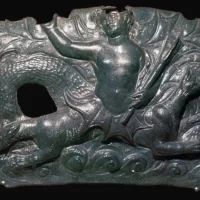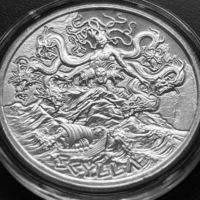Scylla : The Sea Monster
Listen
At a glance
| Description | |
|---|---|
| Origin | Greek Mythology |
| Classification | Hybrids |
| Family Members | Phorcys (Father) Ceto (Mother) |
| Region | Greece |
| Associated With | Sea, Odysseus |
Scylla
Introduction
Scylla, a formidable figure of Greek mythology, is often associated with Homer’s epic, the “Odyssey.” Residing on one side of a perilous strait, she shares her domain with the infamous whirlpool Charybdis. Positioned in such close proximity, sailors navigating these treacherous waters faced a harrowing dilemma: risk the wrath of Scylla’s voracious heads or succumb to the engulfing maw of Charybdis’ swirling depths. This monstrous sea creature, born from the union of powerful deities and cursed by her own beauty, epitomizes the dualities inherent in ancient mythology. Scylla’s name itself has become synonymous with terror and peril, a testament to her enduring presence in maritime lore.
Physical Traits
Scylla’s portrayal in ancient texts, particularly in Homer’s Odyssey, paints a vivid picture of her ghastly appearance. Described as a being with twelve legs and six heads, each adorned with three rows of razor-sharp teeth, she embodies the terror of the uncharted sea. Concealed beneath the waves, her lower body is likened to a writhing mass of snarling dogs or monstrous sea creatures, forever hungering for unwary sailors who stray too near.
This terrifying visage strikes fear into the hearts of even the most courageous seafarers, a testament to the boundless imagination of ancient storytellers who crafted beings both grotesque and awe-inspiring. Later interpretations of Scylla’s physical form introduce additional chilling details, depicting her as a monstrous amalgamation of fish-like appendages, serpent tails, and snapping dog heads encircling her waist. In whichever form she is depicted, Scylla remains a formidable and terrifying presence, a symbol of the dangers lurking in the depths of the sea.
Family
Scylla’s origins remain veiled in the enigmatic depths of Greek mythology, with conflicting narratives leaving her parentage steeped in mystery. Some accounts, such as Hesiod’s Theogony, attribute her lineage to the sea-god Phorcys and the formidable Hecate, goddess of magic, crossroads, and the supernatural. Conversely, Homer and other sources identify her mother as Crataiis, a lesser-known sea nymph, while the identity of her father remains elusive, with conjectures ranging from the monstrous giant Typhon to the merman Triton and the legendary king Tyrrhenius. This ambiguity lends an air of mystique to Scylla, suggesting she may embody primordial forces of nature rather than being bound by conventional familial ties.
Scylla’s familial connections intertwine with the complex tapestry of Greek mythology, weaving together threads of divine lineage and primordial chaos. While some traditions designate her as the daughter of Phorcys, an ancient sea god, and his consort, the sea nymph Crataeis, others delve deeper, implicating notorious sea monsters such as Typhon and Echidna in her lineage. Regardless of the precise genealogy, Scylla’s association with the elemental forces of the sea solidifies her status as a formidable and enduring presence in Greek mythos.
Varied accounts attempt to unravel the lineage of Scylla, yet consensus eludes scholars of ancient lore. According to one strand of mythology, she emerges as the progeny of the deities Phorcys and Ceto, embodying the union of sea and chaos. Alternatively, whispers in the annals of legend suggest a more sinister parentage, tracing her roots to the monstrous coupling of Typhon and Echidna, entities synonymous with terror and destruction. Regardless of the divergent narratives, one truth remains steadfast: Scylla embodies the perilous essence of the sea, a relentless force that strikes fear into the hearts of sailors and storytellers alike.
Other names
Scylla, though primarily known by her singular name, is intricately linked with the sea monster Charybdis in ancient myths, their names entwined in tales of peril for sailors navigating the strait. Her name, “Σκύλλα” (Skylla) in ancient Greek, derives from “skyllo,” meaning “to tear” or “rend,” a fitting descriptor of her predatory nature. Interestingly, alternative monikers are attributed to her depending on the source. Homer occasionally dubs her “the bane of sailors,” underscoring the perpetual threat she posed to seafarers. Meanwhile, Roman writers like Virgil sometimes refer to her as “Ceto,” evoking the monstrous sea creature that ravaged Ethiopia in another Greek myth. These alternate appellations underscore the fear and peril embodied by Scylla throughout various cultural interpretations.
Scylla’s identity transcends singular nomenclature, resonating across different languages and epochs of storytelling. In Latin, she retains the name “Scylla,” echoing its Greek counterpart. However, within ancient texts and oral traditions, she adopts diverse epithets such as “Skylla,” “Skyllaia,” and “Skyllē.” These variations illuminate the adaptable nature of mythological narratives, showcasing how ancient civilizations molded and reshaped stories over time, infusing them with nuances reflective of their cultural lenses.
Powers and Abilities
Scylla’s formidable array of abilities struck terror into the hearts of all who encountered her. Her immense strength and chilling voice, capable of instilling fear in even the bravest sailors, were but the beginning of her menacing prowess. What truly set her apart was her unparalleled speed and agility in the water, enabling her to swiftly seize sailors from passing ships with each of her six heads. The mere sight of her monstrous form, hidden within the confines of a cavern nestled among treacherous cliffs, posed an ominous threat to any who dared to venture near. With razor-sharp teeth and a relentless hunger for destruction, Scylla was an unstoppable force of nature, ensnaring ships and their hapless crews with deadly precision. Some accounts even speak of her possessing a haunting bark, further luring unsuspecting sailors to their doom. Combined, these chilling abilities solidified her reputation as an indomitable predator, forever haunting the perilous waters she called home.
Modern Day Influence
Scylla’s influence permeates modern culture, transcending the boundaries of ancient myth. The expression “between Scylla and Charybdis” has become ingrained in everyday language, symbolizing situations where one faces equally perilous choices, mirroring the essence of her myth – the looming threat of danger with no clear path to safety. Her iconic image finds resonance in various artistic mediums, from literature to video games, serving as a reminder of the monstrous forces lurking in the unknown depths. Yet, perhaps her most profound impact lies in the psychological realm. Scylla embodies the primal fear of the unknown, the lurking dangers concealed beneath the surface of our consciousness. Across literature, film, and scholarly discourse, her legend continues to captivate and inspire, offering insights into the darker facets of human nature and the eternal struggle against the shadows that dwell within us all.
Related Images
Frequently Asked Questions
What is lorem Ipsum?
I am text block. Click edit button to change this text. Lorem ipsum dolor sit amet, consectetur adipiscing elit. Ut elit tellus, luctus nec ullamcorper mattis, pulvinar dapibus leo.
What is lorem Ipsum?
I am text block. Click edit button to change this text. Lorem ipsum dolor sit amet, consectetur adipiscing elit. Ut elit tellus, luctus nec ullamcorper mattis, pulvinar dapibus leo.
What is lorem Ipsum?
I am text block. Click edit button to change this text. Lorem ipsum dolor sit amet, consectetur adipiscing elit. Ut elit tellus, luctus nec ullamcorper mattis, pulvinar dapibus leo.
What is lorem Ipsum?
I am text block. Click edit button to change this text. Lorem ipsum dolor sit amet, consectetur adipiscing elit. Ut elit tellus, luctus nec ullamcorper mattis, pulvinar dapibus leo.
What is lorem Ipsum?
I am text block. Click edit button to change this text. Lorem ipsum dolor sit amet, consectetur adipiscing elit. Ut elit tellus, luctus nec ullamcorper mattis, pulvinar dapibus leo.

